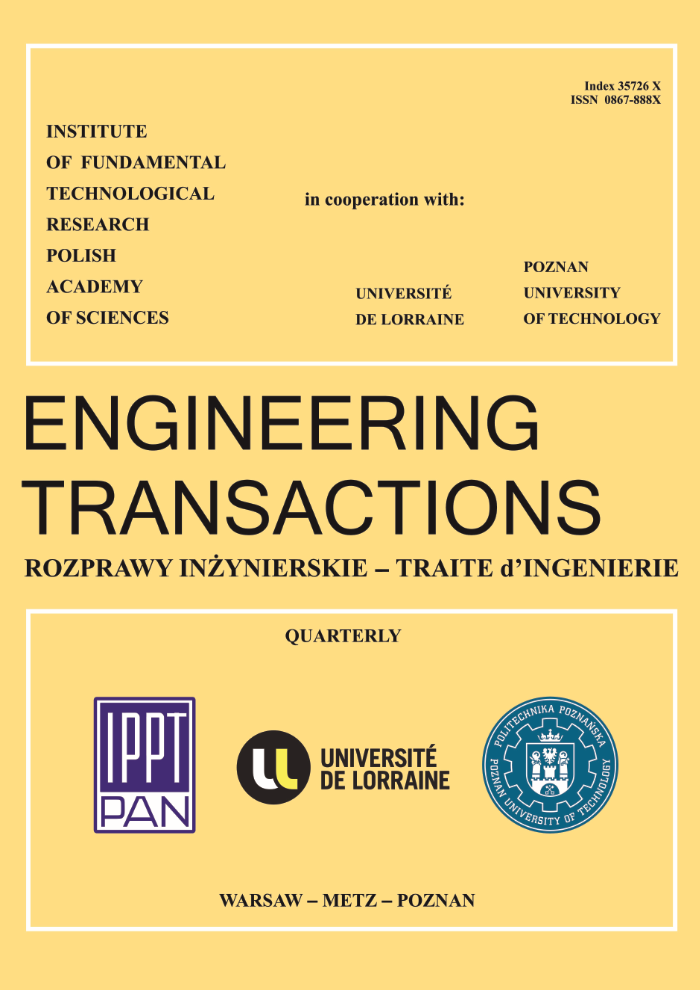Abstract
Stress analysis of the flow of a bimetallic tube in the process of extrusion through a conical die is presented in this paper. Two materials are involved in the process, one of them being of lower thickness and exhibiting finer properties than the other. The stress field is determined by assuming an axially-symmetric radial flow and material incompressibility, with no velocity discontinuity along the material interface and including friction between the bimetallic tube and the tools. Different extrusion conditions and different material combinations are compared to assess their influence on the stress levels in critical zones for the two possible locations of the finer material. It is concluded that the most influential parameters seem to be the yield stress ratio and the friction with the die.References
1. R.T. SHIELD, Plastic flow in a converging conical channel, J. Mech. and Physics of Solids, 3, 246–258, 1955.
2. T.Z. BLAZYNSKI and S. TOWNLEY, The methods of analysis of the process of plug drawing of bimetallic tubing applied to implosively welded composites, Intern. J. Mech. Sciences, 20, 785–797, 1978.
3. D. DURBAN, Drawing and extrusion of composite sheets, wires and tubes, Intern. J. Solids and Structures, 20, 649–666, 1984.
4. A.G. ATKINS and A.S. WEINSTEIN, The deformation of sandwich materials, Intern. J. Mech. Sciences, 12, 641–657, 1970.
5. C.S. HARTLEY, Upper bound analysis of extrusion of axis symmetric, piecewise homogeneous tubes, Intern. J. Mech. Sciences, 15, 651–663, 1973.
6. H. TOKUNO and K. IKEDA, Analysis of deformation in extrusion of composite rods, J. Materials Processing Technology, 26, 323–335, 1991.
7. A.K. TAHERI, Analytical study of drawing of non-bonded trimetallic strips, Intern. J. Machine Tools Manufacturing, 33, 71–88, 1993.
8. D.Y. YANG, Y.G. KIM and C.M. LEE, An upper-bound solution for axisymmetric extrusion of composite rods through curved dies, Intern. J. Machine Tools Manufacturing, 31, 565–575, 1991.
9. B. A.VITZUR, R. WU, S. TALBERT and Y.T. CHOU, Criterion for the prevention of core fracture during extrusion of bimetal rods, ASME J. Engng. for Industry, 104, 293–304, 1982.
10. B. AVITZUR, R. WU, S. TALBERT and Y.T. CHOU, Criterion for the prevention of sleeve fracture during extrusion of bimetal rods, ASME J. Engng. for Industry, 108, 205–212, 1986.
11. K. OSAKADA, M. LIMB and P.B. MELLOR, Hydrostatic extrusion of composite rods with hard cores, Intern. J. Mech. Sciences, 15, 291–307, 1973.
12. A.T. NAGY, Drawing of a material consisting of a hard core and a soft sleeve, J. Mech. Working Technology, 12, 67–77, 1985.
13. O. PAWELSKI and W. RASP, Stresses and strains in deformation of clad metals, [in:] Metal Forming Plasticity, H. LIPPMANN et al. [Eds.], Springer-Verlag, 363–377, 1979.
14. J.R. RICE and D.M. TRACEY, On the ductile enlargement of voids in triaxial stress fields, J. Mech. and Physics of Solids, 17, 201–217, 1969.
15. J.L. ALCARAZ and J. GIL-SEVILLANO, An analysis of the extrusion of bimetallic tubes by numerical simulation, Intern. J. Mech. Sciences, 38, 157–173, 1996.
2. T.Z. BLAZYNSKI and S. TOWNLEY, The methods of analysis of the process of plug drawing of bimetallic tubing applied to implosively welded composites, Intern. J. Mech. Sciences, 20, 785–797, 1978.
3. D. DURBAN, Drawing and extrusion of composite sheets, wires and tubes, Intern. J. Solids and Structures, 20, 649–666, 1984.
4. A.G. ATKINS and A.S. WEINSTEIN, The deformation of sandwich materials, Intern. J. Mech. Sciences, 12, 641–657, 1970.
5. C.S. HARTLEY, Upper bound analysis of extrusion of axis symmetric, piecewise homogeneous tubes, Intern. J. Mech. Sciences, 15, 651–663, 1973.
6. H. TOKUNO and K. IKEDA, Analysis of deformation in extrusion of composite rods, J. Materials Processing Technology, 26, 323–335, 1991.
7. A.K. TAHERI, Analytical study of drawing of non-bonded trimetallic strips, Intern. J. Machine Tools Manufacturing, 33, 71–88, 1993.
8. D.Y. YANG, Y.G. KIM and C.M. LEE, An upper-bound solution for axisymmetric extrusion of composite rods through curved dies, Intern. J. Machine Tools Manufacturing, 31, 565–575, 1991.
9. B. A.VITZUR, R. WU, S. TALBERT and Y.T. CHOU, Criterion for the prevention of core fracture during extrusion of bimetal rods, ASME J. Engng. for Industry, 104, 293–304, 1982.
10. B. AVITZUR, R. WU, S. TALBERT and Y.T. CHOU, Criterion for the prevention of sleeve fracture during extrusion of bimetal rods, ASME J. Engng. for Industry, 108, 205–212, 1986.
11. K. OSAKADA, M. LIMB and P.B. MELLOR, Hydrostatic extrusion of composite rods with hard cores, Intern. J. Mech. Sciences, 15, 291–307, 1973.
12. A.T. NAGY, Drawing of a material consisting of a hard core and a soft sleeve, J. Mech. Working Technology, 12, 67–77, 1985.
13. O. PAWELSKI and W. RASP, Stresses and strains in deformation of clad metals, [in:] Metal Forming Plasticity, H. LIPPMANN et al. [Eds.], Springer-Verlag, 363–377, 1979.
14. J.R. RICE and D.M. TRACEY, On the ductile enlargement of voids in triaxial stress fields, J. Mech. and Physics of Solids, 17, 201–217, 1969.
15. J.L. ALCARAZ and J. GIL-SEVILLANO, An analysis of the extrusion of bimetallic tubes by numerical simulation, Intern. J. Mech. Sciences, 38, 157–173, 1996.






